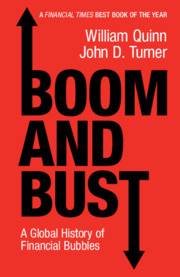Crossref Citations
This Book has been
cited by the following publications. This list is generated based on data provided by Crossref.
Odlyzko, Andrew
2019.
Bagehot's Giant Bubble Failure.
SSRN Electronic Journal ,
EVLİMOĞLU, Umut
and
GÜDER, Mustafa
2021.
TARİHTEKİ EKONOMİK BALONLAR IŞIĞINDA KRİPTO PARALARA GENEL BİR BAKIŞ.
Abant Sosyal Bilimler Dergisi,
Vol. 21,
Issue. 3,
p.
469.
Siklos, Pierre L.
2021.
Did the great influenza of 1918-1920 trigger a reversal of the first era of globalization?.
SSRN Electronic Journal ,
Vogel, Harold L.
2021.
Financial Market Bubbles and Crashes.
p.
55.
2021.
RRPE Books Received: Spring 2021.
Review of Radical Political Economics,
Vol. 53,
Issue. 1,
p.
223.
Siklos, Pierre L.
2021.
Did the Great Influenza of 1918-1920 Trigger a Reversal of the First Era of Globalization?.
SSRN Electronic Journal,
Ghosh, Bikramaditya
Papathanasiou, Spyros
Dar, Vandita
and
Gravas, Konstantinos
2022.
Bubble in Carbon Credits during COVID-19: Financial Instability or Positive Impact (“Minsky” or “Social”)?.
Journal of Risk and Financial Management,
Vol. 15,
Issue. 8,
p.
367.
2022.
Books Received (as of March 2022).
Review of Radical Political Economics,
Vol. 54,
Issue. 1,
p.
136.
Kim, Won Joong
and
Rhee, Hyok-Joo
2022.
Statistical Examination of the Spiraling House Prices in Seoul : Government versus Market.
Journal of Korea Planning Association,
Vol. 57,
Issue. 7,
p.
69.
Haykir, Ozkan
Yagli, Ibrahim
Aktekin-Gok, Emine Dilara
and
Budak, Hilal
2022.
Oil Price Explosivity and Stock Return: Do Sector and Firm Size Matter?.
SSRN Electronic Journal ,
Serrano-Gallardo, Pilar
Manzano, Ana
and
Pawson, Ray
2022.
Non-pharmaceutical interventions during COVID-19 in the UK and Spain: a rapid realist review.
Open Research Europe,
Vol. 2,
Issue. ,
p.
52.
Serrano-Gallardo, Pilar
Manzano, Ana
and
Pawson, Ray
2022.
Non-pharmaceutical interventions during COVID-19 in the UK and Spain: a rapid realist review.
Open Research Europe,
Vol. 2,
Issue. ,
p.
52.
Siklos, Pierre L.
2022.
Did the great influenza of 1918–1920 trigger a reversal of the first era of globalization?*.
International Economics and Economic Policy,
Vol. 19,
Issue. 3,
p.
459.
Garner-Knapp, Lindsey
Western, Shaina D.
and
Lovat, Henry
2022.
European Yearbook of International Economic Law 2021.
Vol. 12,
Issue. ,
p.
3.
Ghosh, Bikramaditya
Papathanasiou, Spyros
Dar, Vandita
and
Kenourgios, Dimitrios
2022.
Deconstruction of the Green Bubble during COVID-19 International Evidence.
Sustainability,
Vol. 14,
Issue. 6,
p.
3466.
Çelik, Ali
and
Ulu, Çağrı
2023.
Testing the Price Bubbles in Cryptocurrencies using Sequential Augmented Dickey-Fuller (SADF) Test Procedures: A Comparison for Before and After COVID-19.
Scientific Annals of Economics and Business,
Vol. 70,
Issue. 1,
p.
1.
Fleming, Grant
Liu, Zhangxin (Frank)
Merrett, David
and
Ville, Simon
2023.
Share ownership and the introduction of no liability legislation in nineteenth-century Australia.
Business History,
p.
1.
Quinn, William
and
Turner, John D.
2023.
Bubbles in history.
Business History,
Vol. 65,
Issue. 4,
p.
636.
Rector, Tully
and
Allen, Jason Grant
2023.
Menger or Marx? The political ontology of cryptocurrency.
Cambridge Journal of Economics,
Vol. 47,
Issue. 3,
p.
535.
Bourghelle, David
2023.
Handbook of Economics and Sociology of Conventions.
p.
1.



